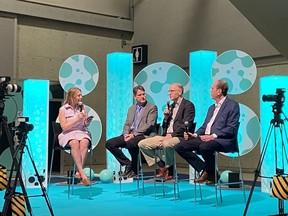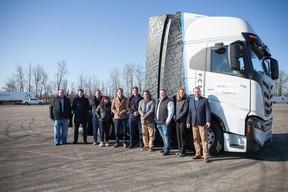The Alberta Motor Transport Association’s AZETEC program will introduce two long haul hydrogen-electric trucks to provincial highways in 2023
Author of the article: Ben Forrest • Postmedia Content Works
Publishing date: Jul 29, 2022 • July 29, 2022

As the Alberta government and other stakeholders develop an energy strategy that may include hydrogen as a major fuel source, the commercial transportation sector is preparing a disruptive innovation that could serve as a blueprint for moving cargo on emissions-free highways.
The Alberta Zero Emissions Truck Electrification Collaboration (AZETEC) is planning to introduce two long haul hydrogen-electric trucks to provincial highways in 2023, moving thousands of kilograms of cargo between Calgary and Edmonton each day without burning a drop of diesel.
“It’s important to look at how we can be more responsible and more effective in controlling emissions,” says Jude Groves, chair of the Alberta Motor Transport Association (AMTA), the industry group spearheading AZETEC.
“As we start to look at that energy transition, and especially with the abundance of opportunity around hydrogen within Alberta, it’s a natural fit for us.”
Alberta is the largest hydrogen producer in Canada, and the province is focused on harnessing that capacity with a strategy called the Alberta Hydrogen Roadmap. The roadmap outlines opportunities to supply both domestic and international markets with low-cost hydrogen.
The worldwide hydrogen market is estimated to reach $2.5 trillion a year by 2050, and Canadians could use it for heating, transportation, industrial processes, power generation and energy storage.
In the transportation sector, some see hydrogen-electric vehicles as an enticing alternative to diesel-burning trucks. Their only tailpipe emission is water vapour.
“We’re really trying to demonstrate that there is an end user market for hydrogen and commercial transportation,” says Groves. “And it can effectively be deployed.”
AZETEC vehicles are designed with four key components: A hydrogen fuel cell, a hydrogen combustion generator, a capacitor battery and an electric motor.
The fuel cell feeds hydrogen into the combustion chamber, where it burns and is converted into electricity. That electricity is stored in the battery and powers the electric motor, which moves the vehicle forward.

Although similar vehicles have been developed in the United States, they’re not designed for Canadian conditions, says Groves.
“The U.S. builds trucks to lower weights, to shorter distances, and does not design them, at least in a preliminary phase, for Canadian climates,” he says. “So we’ve really turned that process on its head, designing a truck that was built to be able to pull Canadian weight, travel distances that are larger than standard long haul vehicles and are built for Canadian climates.”
AZETEC vehicles have a projected range of 700 kilometres and would be supported by the Electric Vehicle Infrastructure Demonstration (EVID), a $2.3 million federal program to establish Canada’s first hydrogen refueling station for commercial vehicles.
In the first year of the program, AZETEC vehicles will be operated by Bison Transport of Winnipeg and Trimac of Calgary, two of Canada’s largest commercial transport companies.
Bison Transport will be hauling a mixture of dry goods, liquids, household items and groceries and will use the AZETEC vehicle as part of its regular network. The company will operate the vehicle on regular routes between Calgary and Edmonton, using the AZETEC tractor to haul two 53-foot trailers.
“We’re very excited and honoured to be a part of the test program,” says Mike Gomes, vice president of maintenance for Bison Transport. “We’ve got a long and documented history of being early adopters of technology that help with sustainability, efficiency of operations and design. It’s a pride thing, to be on that leading edge. We are looking forward to the opportunity to operate this vehicle to gain insight and understanding with a true zero emission tractor as we build out our ESG strategy.”
AZETEC is part of a larger initiative to build Alberta’s hydrogen economy with help from the Hydrogen Centre of Excellence (HCE), an initiative of Alberta Innovates — the province’s largest research and innovation agency. AMTA is a key stakeholder in the project.
HCE intends to accelerate technology across the hydrogen value chain and establish Alberta as a world leader in producing, deploying and using hydrogen across the economy. It also aims to connect researchers, innovators, industry and governments to meet these hydrogen ambitions.
“We’re trying to engage with the commercial transportation industry and the general public to show that this technology is here,” says Jude Groves from AMTA.
“It is on the verge of development and precipice of deployment. [We want] to show that it can successfully work in our environment, with our infrastructure. It’s not some ‘Jetsons’ dream. This transition is happening, and it can happen here successfully.
Groves recognizes that the first two hydrogen-electric trucks from AZETEC won’t immediately change the world, but they’ll serve as a proof of concept, and perhaps a model that can be replicated across Canada.
“It’s an exciting thing,” said Groves. “Usually, people don’t look at the Canadian market and say, ‘Hey, I’m going to build a truck that that satisfies five per cent of truck sales in North America.’
“But we’re building something to say it can be done … we can be a relevant part of that energy transition story.”
For more information, visit amta.ca/what-we-do/research-and-innovation.
This story was created by Content Works, Postmedia’s commercial content division, on behalf of Alberta Motor Transport Association.

